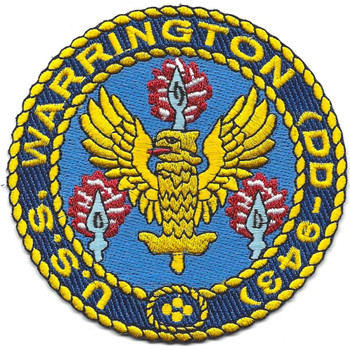Description
USS Warrrington DD-843 Destroyer Ship C Version Patch (U.S. Navy) 3.5" x 3.5" Embroidered Patch with Sew-On Backing
Superior Materials: Made with premium polyester thread and durable twill fabric, ensuring long-lasting color and strength.
Advanced Embroidery Technology: Crafted using the most advanced embroidery machinery, guaranteeing intricate detail, sharp lines, and consistent quality every time.
Easy Iron-On Application: Features a heat-activated adhesive backing for quick, no-sew attachment. Simply position, iron, and press for a secure bond.
Versatile Use: Perfect for personalizing jackets, backpacks, uniforms, or any fabric surface that needs a touch of personality.
Durable and Washable: Designed to withstand everyday wear and occasional washing without fading or fraying.
Formations & Origins
USS Warrington (DD-843) was a Gearing-class destroyer commissioned into the United States Navy on March 23, 1945. Named after Commodore Lewis Warrington, a distinguished naval officer of the early 19th century, the ship was built to serve in the final months of World War II but primarily made her mark during the Cold War era. The Gearing-class was the last and largest class of destroyers built during WWII, designed for anti-submarine warfare, escort duties, and surface combat, embodying versatility and resilience.
Notable Commanders
Over her active service life, USS Warrington was commanded by numerous officers skilled in naval warfare and leadership. These commanders led the ship through a variety of operational theaters, emphasizing readiness, tactical proficiency, and adaptability. The leadership maintained the Warrington’s status as a key player in fleet exercises and missions throughout the volatile Cold War period.
Major Campaigns/Operations
Although commissioned too late to see action in World War II, Warrington had an extensive career throughout the Cold War. She served in the Atlantic, Mediterranean, and Caribbean, participating in numerous NATO exercises and goodwill visits. The destroyer was active during the Cuban Missile Crisis, providing blockade and surveillance duties critical to U.S. naval strategy. Warrington also took part in Vietnam War operations, offering naval gunfire support and escorting carrier task forces.
Specialized Role/Equipment
As a Gearing-class destroyer, USS Warrington was equipped with an array of advanced weaponry for her time, including dual-purpose 5-inch guns, torpedoes, anti-submarine rocket launchers (ASROC), and depth charges. She also featured radar and sonar systems designed to detect and engage submarines and surface threats. The ship underwent several modernizations during her service, notably the FRAM (Fleet Rehabilitation and Modernization) upgrade, which enhanced her anti-submarine warfare capabilities and extended her operational life.
Acts of Heroism
Throughout her deployments, the crew of USS Warrington demonstrated exceptional professionalism and courage, particularly during tense moments such as the Cuban Missile Crisis and Vietnam conflict. Though not widely publicized in singular heroic episodes, the ship’s crew routinely operated under high-stress conditions, conducting patrols and combat support missions with unwavering dedication to duty and the safety of the fleet.
Legacy & Notable Achievements
USS Warrington served faithfully until her decommissioning on June 30, 1973. Her legacy lies in the breadth of her Cold War service, showcasing the vital role of destroyers in fleet defense, power projection, and maritime security. The "C Version" patch reflects her place within the Gearing-class destroyers and often incorporates symbols of naval heritage and firepower. Warrington’s decades of service contributed to the Navy’s deterrent posture and support for U.S. and allied operations worldwide, embodying the spirit of adaptability and steadfastness characteristic of Cold War naval forces.







